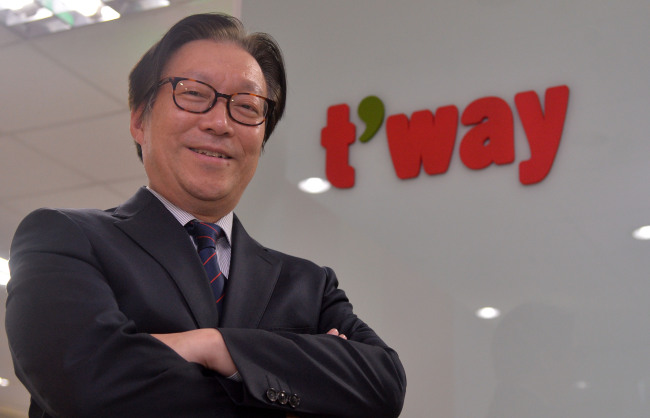T’way Air may be the nation’s smallest budget carrier with just seven short- and midrange aircraft, but it is quickly building a reputation as an innovative player in a market which is reaching a fever pitch of competition.
The carrier, for instance, moved faster than other low-cost carriers to become the first to launch a route between Daegu and Jejudo Island in March.
The same month, the carrier created a sensation by introducing the cheapest-ever early bird promotion fares for domestic and international routes.
In April 2013, it launched a service to share codes with Eastar Jet for its Gimpo (Seoul)-Songshan (Taipei) route so that they may back each other up. It was the first such case between rival budget carriers.
“Carriers like us, armed with cheap flights, have to constantly seek innovation in sales and marketing methods,” T’way Air CEO Hahm Chul-ho said in an interview with The Korea Herald.
 |
T’way Air CEO Hahm Chul-ho. (Lee Sang-sub/The Korea Herald) |
Hahm is a former senior vice president of Korean Air with more than 35 years of experience in the airline industry.
“Another key factor for success is cost control as the airline business is capital-intensive and has high fixed costs.”
According to an analysis by U.S.-based consultancy Oliver Wyman, the average profit margin of airlines around the world was around 1 percent in 2012.
“T’way’s profit margin in 2013 was 2 percent, which was higher than the industry average,” Hahm said. The carrier posted 167 billion won ($160 million) in sales and 4 billion won in operating profit in 2013.
“It will not be easy to lift the firm’s profit margin as the market is expected to become more competitive,’’ he added.
Currently, five local low-cost carriers, including T’way, are in competition. The industry will soon see the arrival of a sixth player, as the nation’s No. 2 airline company Asiana has announced a plan to launch another. The company has been running its first budget carrier, Air Busan, since 2008.
In addition, foreign players are also vying for a place in the market after taking note of the growing number of Korean travelers and foreign visitors to Korea.
“The Korean market is too crowded, considering the market size. Some players will be put on the merger and acquisition market at some point,” the airline industry veteran predicted.
As for T’way’s business strategies, Hahm said the company would not be growth-driven for the time being.
‘‘Instead, we will make efforts to raise efficiency and flexibility to more quickly cope with changing market conditions,” he said. The company does have plans to increase its fleet to 10 by 2015 from the current seven.
T’way started as the country’s first budget carrier, Hansung Airline. It has 506 employees, and swung into the black in the second half of 2013 for the first time in its nine-year history.
By Seo Jee-yeon (
jyseo@heraldcorp.com)








